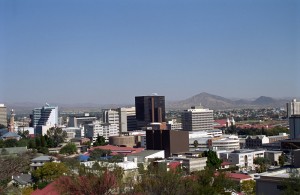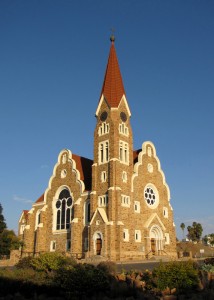 Old German colonialism blends with modern design in Windhoek, Namibia’s capital city. It is situated in and airy basin in the central highlands amid rolling mountains. Windhoek is the perfect place to begin or end a Namibian holiday. Its laid-back atmosphere warmly encompasses the funky, eclectic inhabitants. It is one of the most relaxing and safest cities in Southern Africa and provides a conduit to Etosha National Park, Namib-Naukluft Park, and the resort town of Swakopmund with a multitude of adventure activities.
Old German colonialism blends with modern design in Windhoek, Namibia’s capital city. It is situated in and airy basin in the central highlands amid rolling mountains. Windhoek is the perfect place to begin or end a Namibian holiday. Its laid-back atmosphere warmly encompasses the funky, eclectic inhabitants. It is one of the most relaxing and safest cities in Southern Africa and provides a conduit to Etosha National Park, Namib-Naukluft Park, and the resort town of Swakopmund with a multitude of adventure activities.Despite its small population Windhoek boasts a complex history intertwining a variety of “native” backgrounds. People within the city vary from the fairest blondes to the deepest black skin tones, and all combinations in between. Women display intricate hairstyles and local residents from outside the city often wear traditional dress from their tribal background.
The town center provides quaint shops and market stalls perfect for the pedestrian only traffic. “People watching” exists as the perfect pastime while patrons enjoy the multitude of diverse cafes. The cafes become even more popular between December and February. During the hot days they make unique places to enjoy a cold drink and when the high altitude and humidity cause temperatures to drop, a cool breeze makes the café atmosphere pleasantly cooled.
Windhoek was situated near the epicenter of the country due to planning by the Germanic colonial settlers. Summer downpours are regular occurrences. The moisture evaporates quickly so the dampness doesn’t last long. Weather in winter become very cold during the night forming frost in low lying areas, but the warmth of the sunny days makes travel still enjoyable at that time of year.
 The size of Windhoek is small for a capital city with only 200,000 residents. The city is growing rapidly because there are few employment opportunities in the rural surroundings. Windhoek is an extremely clean, safe city unlike some other areas in Africa. Several significant historical buildings are worth visiting: Alte Feste (the old fort), the parliament buildings (Tintenpalast), and Christuskiche are only a few. The old fort currently houses the National Museum emphasizing Namibia’s struggle for freedom and Namibian independence.
The size of Windhoek is small for a capital city with only 200,000 residents. The city is growing rapidly because there are few employment opportunities in the rural surroundings. Windhoek is an extremely clean, safe city unlike some other areas in Africa. Several significant historical buildings are worth visiting: Alte Feste (the old fort), the parliament buildings (Tintenpalast), and Christuskiche are only a few. The old fort currently houses the National Museum emphasizing Namibia’s struggle for freedom and Namibian independence.
The nightlife in the center of the city makes popular bars, restaurants and nightclubs rock year round. This socialization has spread beyond the city center into the suburbs and nearby townships. Nightlife can continue throughout the weekend and visitors can be in for the time of their lives. Windhoek houses Namibia’s brewing industry which adds to the atmosphere of gaiety. There are banks, pharmacies, supermarkets, bakeries, clothes shops, the Maerua Mall where one can utilize the indoor swimming pool and gym or shop ‘til you drop. This city is a holiday in and of itself.
Travelerscan stay in a variety of places ranging from hostels for backpackers, bed and breakfasts, guesthouses to luxury hotels. Windhoek sponsors a German carnival complete with bread, sausage and beer. This demonstrates that the German influence continues to be cultivated in this unique capital city.






[...] Windhoek Namibia [...]